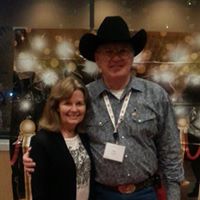Gary D Alley
age ~82
from Strafford, MO
- Also known as:
-
- Gary Dean Alley
- Gary Dalley
- Phone and address:
-
1198 N West Ridge Dr, Strafford, MO 65757
(417)7362927
Gary Alley Phones & Addresses
- 1198 N West Ridge Dr, Strafford, MO 65757 • (417)7362927
- Allerton, IA
- 604 Greentree Rd, Rolla, MO 65401 • (573)3081483
- 17 Holton Cir, Londonderry, NH 03053 • (603)4323473
- Greenview, MO
Work
-
Position:Executive, Administrative, and Managerial Occupations
Education
-
Degree:Bachelor's degree or higher
Us Patents
-
Rf Power Supply With Integrated Matching Network
view source -
US Patent:6887339, May 3, 2005
-
Filed:Sep 20, 2001
-
Appl. No.:09/960227
-
Inventors:Daniel Goodman - Lexington MA, US
Andrzej Bortkiewicz - Hamilton MA, US
Gary D. Alley - Londonderry NH, US
Stephen F. Horne - Chelmsford MA, US
William M. Holber - Winchester MA, US -
Assignee:Applied Science and Technology, Inc. - Wilmington MA
-
International Classification:H05H001/00
C23C016/00 -
US Classification:15634528, 15634548, 15634547, 15634541, 118723 E, 118723 I, 118723 MW
-
Abstract:The invention features an RF plasma generator. The RF plasma generator includes a variable frequency RF generator, comprising an H-bridge and an RF output. The RF generator generates electromagnetic radiation having a power. The RF plasma generator further includes a matching network that includes at least one variable impedance component. The matching network also includes a first port that is electromagnetically coupled to the output of the RF generator and a second port. The RF plasma generator also includes a load that is electromagnetically coupled to the second port of the matching network, and a plasma chamber for containing a plasma having a power. The plasma chamber is electromagnetically coupled to the load and receives electromagnetic radiation having a power from the load. Adjusting at least one of the frequency of the RF generator and the variable impedance component in the matching network changes the power in the plasma.
-
Semiconductor Embedded Layer Technology Utilizing Selective Epitaxial Growth Methods
view source -
US Patent:50325388, Jul 16, 1991
-
Filed:Jul 7, 1987
-
Appl. No.:7/073912
-
Inventors:Carl O. Bozler - Sudbury MA
Gary D. Alley - Londonderry NH
William T. Lindley - Lexington MA
R. Allen Murphy - Hudson MA -
Assignee:Massachusetts Institute of Technology - Cambridge MA
-
International Classification:H01L 2120
H01L 2174
H01L 2195 -
US Classification:437 83
-
Abstract:A permeable base transistor (30) including a metal base layer (34) embedded in a semiconductor crystal (32) to separate collector (38) and emitter (40) regions and form a Schottky barrier with each is disclosed. The metal base layer has at least one opening (37) through which the crystal semiconductor (32) joins the collector (38) and emitter (40) regions. Ohmic contacts (42,44) are made to the emitter (38) and collector (40) regions. The width of all openings (37) in the base layer (34) is of the order of the zero bias depletion width corresponding to the carrier concentration in the opening. The thickness of the metal layer (34) is in the order of 10% of this zero bias depletion width. As a result, a potential barrier in each opening limits current flow over the lower portion of the bias range. With increasing forward base bias the potential in the openings, which is lower than along the metal of the base layer (34), is lowered sufficiently to permit substantial increase in the barrier limited current flow from the collector (38) to emitter (40).
-
Semiconductor Embedded Layer Technology Including Permeable Base Transistor
view source -
US Patent:52987876, Mar 29, 1994
-
Filed:Apr 1, 1991
-
Appl. No.:7/678670
-
Inventors:Carl O. Bozler - Sudbury MA
Gary D. Alley - Londonderry NH
William T. Lindley - Lexington NH
R. Allen Murphy - Hudson MA -
Assignee:Massachusetts Institute of Technology - Cambridge MA
-
International Classification:H01L 27082
H01L 2900
H01L 27102
H01L 2930 -
US Classification:257592
-
Abstract:A permeable base transistor (30) including a metal base layer (34) embedded in a semiconductor crystal (32) to separate collector (38) and emitter (40) regions and form a Schottky barrier with each is diclosed. The metal base layer has at least one opening (37) through which the crystal semiconductor (32) joins the collector (38) and emitter (40) regions. Ohmic contacts (42,44) are made to the emitter (38) and collector (40) regions. The width of all openings (37) in the base layer (34) is of the order of the zero bias depletion width corresponding to the carrier concentration in the opening. The thickness of the metal layer (34) is in the order of 10% of this zero bias depletion width. As a result, a potential barrier in each opening limits current flow over the lower portion of the bias range. With increasing forward base bias the potential in the openings, which is lower than along the metal of the base layer (34), is lowered sufficiently to permit substantial increase in the barrier limited current flow from the collector (38) to emitter (40).
-
Monolithic Single And Double Sideband Mixer Apparatus
view source -
US Patent:45532656, Nov 12, 1985
-
Filed:Dec 8, 1983
-
Appl. No.:6/559609
-
Inventors:Brian J. Clifton - Sudbury MA
Gary D. Alley - Londonderry NH -
International Classification:H04B 126
-
US Classification:455325
-
Abstract:A monolithic mixer which is impedance matched to a fundamental waveguide, utilizes a slot coupler and a coplanar transmission line to apply an RF and local oscillator signal to a Schotty-barrier diode. The dielectric substrate is utilized to create a dielectric surface wave resonance which is utilized by centering a slot coupler with respect thereto, to provide a reactive image termination at the upper sideband and thereby enhance single and double sideband mixer operation. The IF signal which is available at the output of the Schottky-barrier diode is filtered by means of an RF bypass capacitor that is located on the dielectric substrate surface.
-
Semiconductor Embedded Layer Technology Including Permeable Base Transistor, Fabrication Method
view source -
US Patent:43786294, Apr 5, 1983
-
Filed:Aug 10, 1979
-
Appl. No.:6/065514
-
Inventors:Carl O. Bozler - Sudbury MA
Gary D. Alley - Londonderry NH
William T. Lindley - Lexington MA
R. Allen Murphy - Hudson MA -
Assignee:Massachusetts Institute of Technology - Cambridge MA
-
International Classification:H01L 2120
H01L 2174
H01L 2195 -
US Classification:29580
-
Abstract:A layer of material such as the metal base of a transistor is embedded in single crystal. A layer of the material with small, uniformly dimensioned and uniformly spaced openings is formed on a single crystal substrate, and the single crystal is grown from the exposed portions of the substrate over the layer of material. For best results, the layer of material to be embedded is deposited relative to the crystal orientation to provide a much greater rate of crystal growth laterally across the layer than away from the crystal substrate. The method is particularly useful in fabricating a permeable base transistor having slits formed in the metal base layer. An integrated circuit can be fabricated by forming a pattern of conductive material on a single crystal, that pattern having continuous regions which inhibit further crystal growth and narrow regions or regions having openings therein which permit lateral crystal growth across those regions. In that way, the conductive pattern is selectively embedded with the continuous regions left exposed after crystal growth. Connections can be made between the exposed regions and a pattern on the new crystal layer.
-
Intermodulation Distortion Reduction Method And Apparatus
view source -
US Patent:59306785, Jul 27, 1999
-
Filed:May 13, 1996
-
Appl. No.:8/645302
-
Inventors:Gary Dale Alley - Londonderry NH
Yen-Long Kuo - Andover MA -
Assignee:Lucent Technologies Inc - Murray Hill NJ
-
International Classification:H04H 102
H04N 710
H04J 1500 -
US Classification:455 61
-
Abstract:A method and apparatus for providing spectral control of intermodulation products in communications systems to reduce the distorting and interfering effects of system nonlinearities. The method provides a technique which controls the phases of video carriers in order to minimize second and third order intermodulation distortion products both in-band and out-of-band.
-
Integrated Circuit Mixer Apparatus
view source -
US Patent:44110227, Oct 18, 1983
-
Filed:Jan 27, 1982
-
Appl. No.:6/343034
-
Inventors:Brian J. Clifton - Sudbury MA
Gary D. Alley - Londonderry NH
Ralph A. Murphy - Hudson MA -
Assignee:The United States of America as represented by the Secretary of the Air
Force - Washington DC -
International Classification:H04B 126
-
US Classification:455327
-
Abstract:An integrated circuit mixer which is impedance matched to a fundamental waveguide, utilizes a slot coupler and a coplanar transmission line to apply an RF and local oscillator signal to a Schottky-barrier diode. The IF signal which is available at the output of the Schottky-barrier diode is filtered by means of an RF bypass capacitor that is located on the dielectric substrate surface. At 110 GHz, a mixer module when mounted in the end of a waveguide horn, has an uncooled double-sideband (DSB) mixer noise temperature of 339. degree. K. and conversion loss of 3. 8 dB.
Resumes

Gary Alley
view sourceLocation:
Strafford, MO
Industry:
Architecture & Planning
Work:
Getting There Is Half the Fun!
Retired
Retired

Gary Alley
view source
Gary Alley
view source
Gary Alley
view sourceName / Title
Company / Classification
Phones & Addresses
#2631 Store Manager
The Sherwin Williams Company
Paint - Retail. Wallpapers & Wallcoverings - Retail
Paint - Retail. Wallpapers & Wallcoverings - Retail
2323 21st Avenue, Suite 402, Nashville, TN 37212
(615)2975148, (615)2975148
(615)2975148, (615)2975148
Principal
Letter Carriers, Rural, Ind Local Union 0
Labor Organization
Labor Organization
2794 Hwy S22, Harvard, IA 50008
Myspace
Flickr

Gary Alley
view source
Gary Alley
view source
Gary Alley
view source
Gary Alley
view source
Gary Alley
view source
Gary Alley
view source
Gary Alley
view source
Gary Alley
view sourceOther Social Networks

Gary Alley Google+
view sourceNetwork:
GooglePlus
Gary Alley - - - ... Have Gary in circles (14). View all . Report this profile ... MoreLoading... Gary has not filled out their profile yet. ...
Classmates

Gary Alley
view sourceSchools:
Independence High School Independence VA 1968-1973
Community:
Marie Hanauer, William Harvey

Gary Alley
view sourceSchools:
Ft. Chiswell High School Max Meadows VA 1986-1990
Community:
Sarah Arnold, Treva Snavely

Gary Alley
view sourceSchools:
North Adams High School North Adams MI 1959-1963
Community:
Kathleen Bayless, Brent Denning, Bonnie Bobbi, Peter Ensign

Gary Alley
view sourceSchools:
School Three Middle School Ecorse MI 1952-1959
Community:
Claudia Harjes, Paulette Stineman, Norma Salliotte, Bonnie Duenas

Gary Alley
view sourceSchools:
Edison Elementary School Ashland KY 1962-1966, Clark High School Winchester KY 1966-1970
Community:
Bob Maynard, Linda Swafford

Gary Joe Alley
view sourceSchools:
Blaine High School Blaine KY 1954-1958
Community:
James Mulkey, Sue Smith, Carolyn Mosley, Diana Fyffe

Gary Alley
view sourceSchools:
Classen High School Oklahoma City OK 1971-1975
Community:
Nila Stone, Daniel Nicklas, Tammy Boyd, Guy Lewis

Gary Alley, Franklin High...
view sourceGoogleplus

Gary Alley
Tagline:
Geek and Weather enthusiast.
Youtube
Get Report for Gary D Alley from Strafford, MO, age ~82













